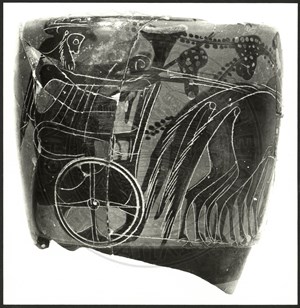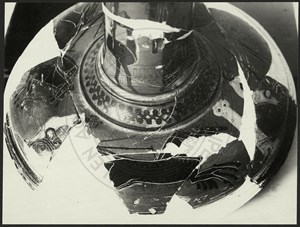Kalathos
The kalathos is not related to the Mysteries in Eleusis but appears in the Mysteries of Alexandria. In this Hellenistic city of Egypt, there was a suburb known as Eleusis. It was located east of the town, outside the Canopus Gate. The name is due to the decision of King Ptolemy II to establish a local cult of Demeter. The annual celebrations in Alexandrian Eleusis included music and sports, recitations and dramatic performances inspired by the story of Demeter and Kore. The worship content is not known in detail. Still, it would probably have noticeable differences from the ceremonies of the Greater Mysteries since faithful imitation would be disrespectful to the goddesses.

Pyre B. Fragment of a black-figure lekythos [chariot], Konstantina Kokkou-Vyridi, photograph, Εν Αθήναις Αρχαιολογική Εταιρεία © Η εν Αθήναις Αρχαιολογική Εταιρεία

Pyre B. Blac-figure censer [chariot race], Konstantina Kokkou-Vyridi, photograph, Εν Αθήναις Αρχαιολογική Εταιρεία © Η εν Αθήναις Αρχαιολογική Εταιρεία
The adoption of new elements and local variations in the Mysteries of Eleusis was a common practice in the Greek world. For example, the kalathos, which does not appear in the Eleusinian tradition or art or ancient references, played a (vague) role in the ceremonies in Eleusis of Alexandria. According to the Hymn to Demeter composed by the poet Callimachus of Cyrene, the ignorant and profane were instructed to lower their gaze so that their filthy eyes would not see the kalathos crossing the city streets on a chariot drawn by four white horses and accompanied by barefoot and bareheaded women and other escorts carrying cradles full of gold objects. The purpose of the ban was to protect the sacred objects held in the kalathos from the eyes of those who were not allowed to see them.






